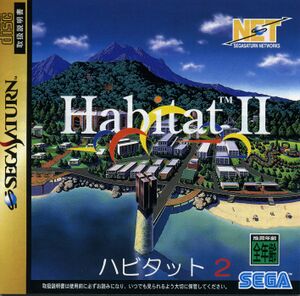Habitat II
| Developer(s): | Fujitsu Limited |
|---|---|
| Publisher(s): | Fujitsu Limited |
| Platform(s): | Windows, Mac, Sega Saturn |
| Released: | March 1996 |
Origins
In 1993, Fujitsu had shown interest in bringing Fujitsu Habitat to the west. The plan was to backport Fujitsu Habitat to Windows computers. However, the source code for Fujitsu Habitat revealed major architectural problems and so minimal progress was made on bringing this to fruition. It was instead decided that development efforts would be better focused on writing something from the ground up. The original creators of Habitat, Chip Morningstar and Randy Farmer were both onboard and had already done this once before.
A team in Japan was formed and they received regular code updates and support from the American WorldsAway team. The Japanese team localized everything and even added new features, such as the ability to record your session and play it back offline at any time. This was done by recording packets sent to and from the server and because of the design of the WorldsAway client, it wouldn't be able to tell the difference between receiving that data from a live server or playing back an offline recording.
Habitat II was planned from the start as a way to transition from the FM Towns, over to more modern computers. The initial world setting was custom made by Fujitsu in Japan specifically for Habitat II and it looked like a near future version of a Japanese city. This became known as Elysium and it was specifically designed with ease of use in mind and with a view that it should be simple for adults and children alike to navigate. Later on, a second Habitat II world was established named Graceville. Graceville was a copy of WorldsAway's Dreamscape and used the 2.x client and server architecture, whilst Elysium remained using the 1.x client and server. Both Elysium and Graceville were set on the island of Intercosm, with Elysium being on its southern tip.
Things
Habitat II v2.0 Development Staff
This data was taken from the credits section of the Habitat II V2.0 client.
| Title | Name (English) | Name (Japanese) |
|---|---|---|
| Executive Producer | Kazutomo Fukuda | 福田 和智 |
| Director | Kenji Sugawara | 菅原 健次 |
| Production Manager | Tadayuki Tahara | 田原 忠行 |
| Public Relations | Makoto Urano | 浦野 真 |
| Etsuko Iwata | 岩田 恵津子 | |
| Server Development | Kazuhiro Ouchi | 大内 和博 |
| Kiyomi Ito | 伊東 清美 | |
| Fumitoyo Takizawa | 滝沢 文豊 | |
| Satoshi Sato | 佐藤 哲 | |
| Client Development | Manabu Yanagida | 柳田 学 |
| Makoto Minamijima | 南島 誠 | |
| Yuji Aoki | 青木 勇治 | |
| Takanori Sasaki | 笹木 孝倫 | |
| Porting Support | Yuichi Kojima | 小島 祐一 |
| Space Design/Direction | Ko Naka | 中 恒 |
| Art Design | Fujitsu Apprico | 富士通アプリコ |
| Ultra Digital | ウルトラ・デジタル | |
| Aibit | エイビット | |
| Voice Actors/Cast | Koji Ochiai | 落合 弘治 |
| Atsushi Goto | 後藤 敦 | |
| Yuko Maruyama | 丸山 裕子 | |
| Masako Watanabe | 渡辺 真砂子 | |
| Emiko Kuriyama | 栗山 微笑子 | |
| Special Thanks | Media Mix | メディアミックス |
| Algonyx | アルゴニクス | |
| Warabe | 童 | |
| Robot | ロボット | |
| Toa Eizo Rokuon | 東亜映像録音 | |
| Studio Echo | スタジオ・エコー | |
| Fujitsu Social Science Laboratory | 富士通ソーシアルサイエンスラボラトリ | |
| Fujitsu Parex | 富士通パレックス | |
| Fujitsu System Business of America, Inc | N/A |
More to come soon
Here's some more stuff.
Even more stuff
Here it is.
